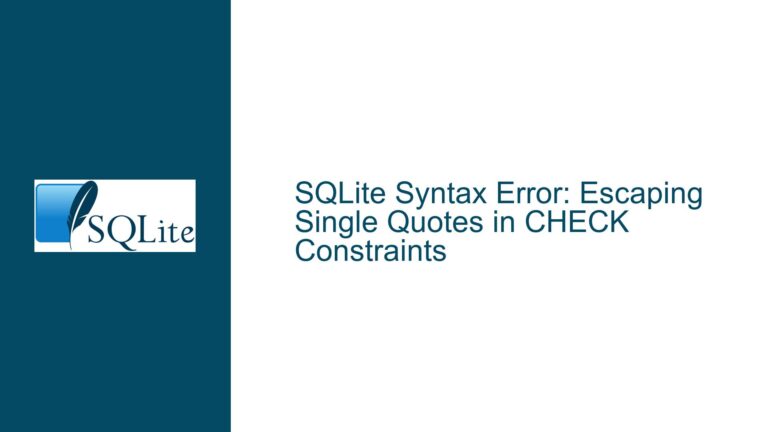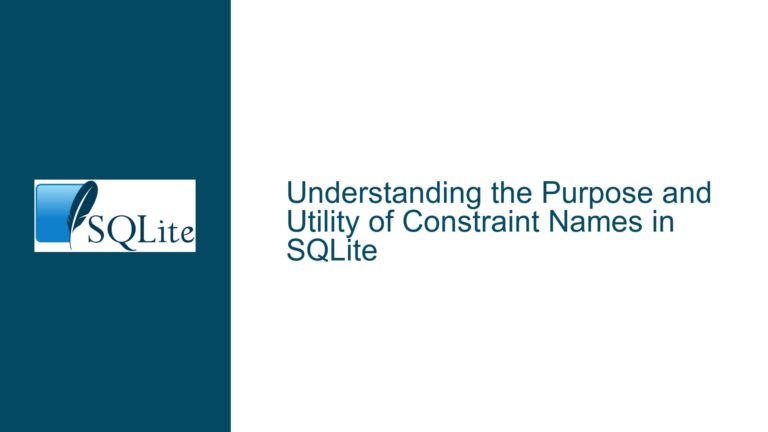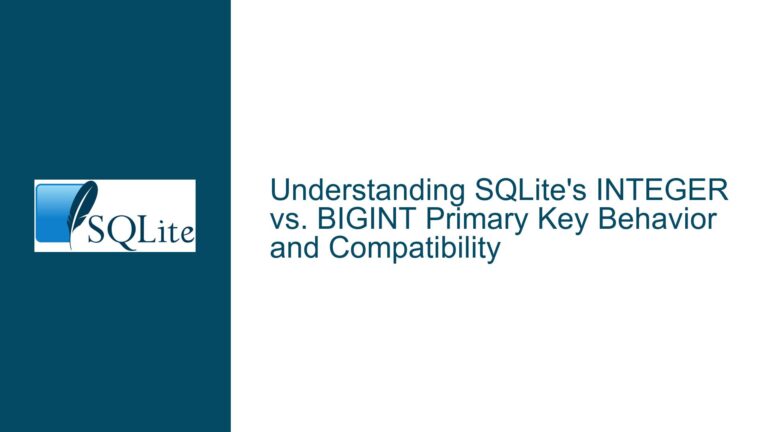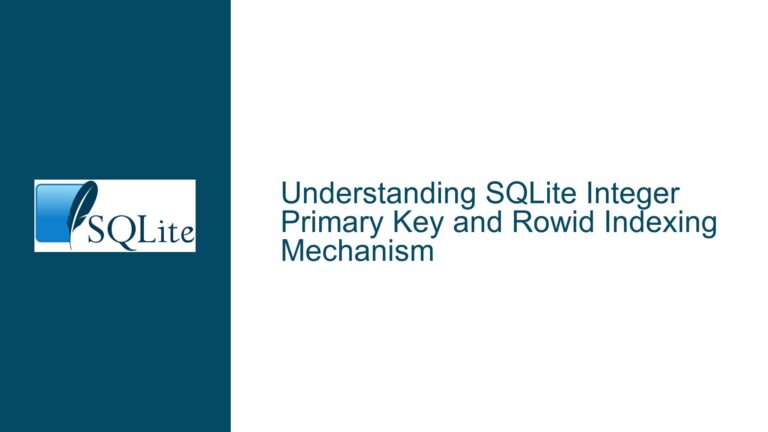Efficiently Managing Evolving XML Schemas in SQLite Databases
Issue Overview: Repeated ETL Overhead Due to Missing XML Attributes
The core challenge revolves around managing a large-scale XML data ingestion pipeline (700,000+ XML documents) with SQLite, where the initial ETL (Extract-Transform-Load) process omitted critical attributes. This forces a full reprocessing cycle when new attributes are required, resulting in significant time and resource costs. The user seeks a future-proof strategy to avoid re-ingesting all XML data whenever schema changes occur.
Key technical constraints include:
- Schema Rigidity: The current SQLite schema maps specific XML tags/attributes to dedicated tables/columns. Adding new attributes requires altering tables or rebuilding the entire database.
- Performance Trade-offs: SQLite lacks native XML querying capabilities (e.g., XPath/XQuery), making dynamic extraction impractical. Alternatives like XML databases are dismissed due to inferior speed/simplicity.
- Storage Efficiency: The existing database uses FTS5 and R*Tree indexes (19GB total), but adding new indexes for future attributes risks ballooning storage and backup times.
The user’s workflow involves nightly ETL jobs that parse XMLs into structured tables. A critical oversight in attribute extraction exposed the fragility of this approach, prompting a search for alternatives that balance flexibility (handling schema changes) with SQLite’s performance advantages.
Possible Causes: Schema Inflexibility and Incomplete Data Extraction
Hard-Coded Tag/Attribute Mapping:
The ETL process rigidly maps XML elements to predefined tables/columns (e.g.,<pt id="...">→pt.pt_id). This design assumes a fixed schema, making it impossible to retroactively extract new attributes without reprocessing all XMLs.Lack of Forward Compatibility:
The initial ETL logic did not account for future schema changes. Attributes deemed non-critical were discarded during extraction, leaving no mechanism to recover them without re-parsing raw XMLs.Indexing Strategy Limitations:
Heavy reliance on FTS5 for text search and R*Tree for spatial data creates dependencies on specific column structures. Adding new indexes for unforeseen attributes complicates query optimization and storage management.XML-to-Relational Mismatch:
XML’s hierarchical, semi-structured nature clashes with SQLite’s tabular model. Without a generic way to store nested or variable attributes (e.g., via JSON blobs or adjacency lists), schema changes become disruptive.ETL Process Bottlenecks:
Reprocessing 700K XMLs nightly is resource-intensive. Parallelizing extraction (e.g., via compiled languages) was not implemented, leading to linear processing bottlenecks exacerbated by schema changes.
Troubleshooting Steps, Solutions & Fixes: Adaptive Schema Design and Hybrid Storage
1. Normalize XML Structures into Generic Tables
Problem: Hard-coded table/column mappings require schema alterations for new attributes.
Solution: Store XML elements/attributes in a generic, hierarchical format using three tables:
CREATE TABLE xml_nodes (
node_id INTEGER PRIMARY KEY,
parent_id INTEGER REFERENCES xml_nodes(node_id),
element_name TEXT NOT NULL, -- e.g., "pt", "st1"
node_type TEXT CHECK(node_type IN ('element', 'attribute', 'text')),
value TEXT,
document_id INTEGER -- Links to source XML
);
CREATE TABLE xml_attributes (
node_id INTEGER REFERENCES xml_nodes(node_id),
attribute_name TEXT, -- e.g., "id", "name"
attribute_value TEXT
);
CREATE TABLE xml_documents (
document_id INTEGER PRIMARY KEY,
xml_hash BLOB UNIQUE, -- Detect duplicate XMLs
processed_at TIMESTAMP
);
Benefits:
- Captures all elements/attributes without upfront schema decisions.
- Enables XPath-like queries via recursive CTEs:
WITH RECURSIVE pt_elements AS (
SELECT node_id, element_name, value
FROM xml_nodes
WHERE element_name = 'pt'
UNION
SELECT n.node_id, n.element_name, n.value
FROM xml_nodes n
JOIN pt_elements p ON n.parent_id = p.node_id
)
SELECT * FROM pt_elements;
Trade-offs:
- Increased query complexity for nested elements.
- Requires indexing
element_name,attribute_name, anddocument_idfor performance.
2. Leverage SQLite Extensions for XML Querying
Problem: SQLite lacks native XML support, forcing full ETL reprocessing for new attributes.
Solution: Integrate XPath extensions like sqlite-xpath or XMLite:
-- Using sqlite-xpath (example syntax)
SELECT xpath_get(xml_blob, '/pt/@id') AS pt_id
FROM raw_xml_documents
WHERE document_id = 123;
Implementation Steps:
- Store raw XMLs in a table with a
TEXTorBLOBcolumn:CREATE TABLE raw_xml_documents ( document_id INTEGER PRIMARY KEY, xml_content TEXT NOT NULL ); - Load the XPath extension at runtime:
sqlite3 mydb.db "SELECT load_extension('sqlite_xpath');" - Create virtual tables for on-demand extraction:
CREATE VIRTUAL TABLE xml_xpath USING xpath( content=raw_xml_documents.xml_content, namespaces='...', schema='...' );
Benefits:
- Eliminates ETL for new attributes; query raw XMLs directly.
- Avoids database alterations when requirements change.
Trade-offs: - Slower than precomputed indexes (full XML parsing at query time).
- Requires compiling/maintaining third-party extensions.
3. Hybrid Approach: Store Raw XMLs with Extracted Metadata
Problem: Reprocessing XMLs is time-consuming, but querying raw XMLs is slow.
Solution: Combine raw XML storage with selective indexing:
CREATE TABLE hybrid_documents (
document_id INTEGER PRIMARY KEY,
xml_content TEXT NOT NULL, -- Raw XML
extracted_data JSON NOT NULL -- Critical attributes as JSON
);
-- JSON1 example: Extract "id" and "name" from XML
INSERT INTO hybrid_documents (document_id, xml_content, extracted_data)
VALUES (
123,
'<pt id="6TYFR" name="foo">...</pt>',
json_object(
'pt_id', xpath_get(xml_content, '/pt/@id'),
'name', xpath_get(xml_content, '/pt/@name')
)
);
Querying:
-- Use JSON1 for existing attributes
SELECT json_extract(extracted_data, '$.pt_id')
FROM hybrid_documents
WHERE json_extract(extracted_data, '$.name') = 'foo';
-- Fallback to XPath for new attributes
SELECT xpath_get(xml_content, '/pt/@new_attr')
FROM hybrid_documents
WHERE document_id = 123;
Benefits:
- Balances storage overhead (raw XMLs) with query performance (indexed JSON).
- New attributes are accessible via XPath without reprocessing.
Optimizations: - Use
ATTACH DATABASEto isolate raw XMLs in a separate file. - Compress
xml_contentwithzliborZSTD(via sqlite-compressions).
4. Automate Schema Migrations with XSLT Transformations
Problem: Manual ALTER TABLE statements are error-prone and slow.
Solution: Use XSLT to generate SQL schemas and ETL logic:
- Define an XSLT template that maps XML elements to tables/columns:
<!-- Example: Extract <pt> attributes --> <xsl:template match="pt"> <sql> INSERT INTO pt (pt_id, name, fulltext) VALUES ('<xsl:value-of select="@id"/>', '<xsl:value-of select="@name"/>', '<xsl:value-of select="normalize-space(.)"/>'); </sql> </xsl:template> - Generate ALTER TABLE statements dynamically:
<xsl:template match="pt/@new_attr"> <sql> ALTER TABLE pt ADD COLUMN new_attr TEXT; UPDATE pt SET new_attr = '<xsl:value-of select="."/>' WHERE pt_id = '<xsl:value-of select="../@id"/>'; </sql> </xsl:template> - Execute generated SQL via a script (Python/Node.js):
import sqlite3 from lxml import etree xslt = etree.parse("schema_generator.xsl") transform = etree.XSLT(xslt) xml = etree.parse("data.xml") sql_script = str(transform(xml)) conn = sqlite3.connect("mydb.db") conn.executescript(sql_script)
Benefits:
- Schema changes are codified in XSLT, reducing manual SQL scripting.
- Enables partial updates (e.g., backfilling
new_attrfor existing records).
5. Incremental ETL with Document Versioning
Problem: Full reprocessing wastes resources when only a subset of XMLs changes.
Solution: Track document versions and process deltas:
- Add a
versioncolumn to detect changes:CREATE TABLE xml_documents ( document_id INTEGER PRIMARY KEY, xml_hash TEXT UNIQUE, -- SHA-256 of content version INTEGER DEFAULT 1, processed_at TIMESTAMP ); - During nightly ETL, identify unprocessed/updated XMLs:
-- New documents SELECT * FROM xml_documents WHERE processed_at IS NULL; -- Updated documents (compare hashes) SELECT * FROM incoming_xmls WHERE xml_hash NOT IN (SELECT xml_hash FROM xml_documents); - Process only delta records and update version:
# Pseudocode for parallel processing find incoming/ -name '*.xml' | xargs -P 8 -n 1 python etl_worker.py
Optimizations:
- Use
WITHOUT ROWIDtables for faster hash lookups. - Partition
xml_documentsbydocument_id % 64to reduce contention.
6. Materialized Views for Common Query Patterns
Problem: Hierarchical XML queries (CTEs) are slow over generic tables.
Solution: Precompute frequent queries into materialized views:
-- Materialize all <pt> attributes
CREATE TABLE mv_pt_attributes AS
WITH RECURSIVE pt_tree AS (
SELECT node_id, element_name, value
FROM xml_nodes
WHERE element_name = 'pt'
UNION
SELECT n.node_id, n.element_name, n.value
FROM xml_nodes n
JOIN pt_tree p ON n.parent_id = p.node_id
)
SELECT * FROM pt_tree;
-- Refresh view incrementally
CREATE TRIGGER trg_xml_nodes_update
AFTER INSERT ON xml_nodes
FOR EACH ROW WHEN NEW.element_name = 'pt'
BEGIN
INSERT INTO mv_pt_attributes (node_id, element_name, value)
VALUES (NEW.node_id, NEW.element_name, NEW.value);
END;
Benefits:
- Avoids recursive CTE overhead for common queries.
- Incremental updates reduce refresh times.
Final Recommendations
- Short Term: Implement the hybrid approach (raw XML + JSON metadata) to avoid reprocessing while retaining query flexibility.
- Medium Term: Migrate to a normalized node/attribute schema with materialized views for critical queries.
- Long Term: Integrate XPath extensions and automate schema migrations via XSLT to handle evolving requirements.
By decoupling raw XML storage from indexed attributes and leveraging SQLite’s extensibility, you can achieve a balance between flexibility and performance, eliminating the need for full ETL reprocessing when schema changes occur.






